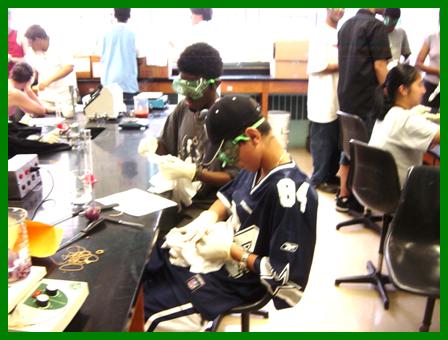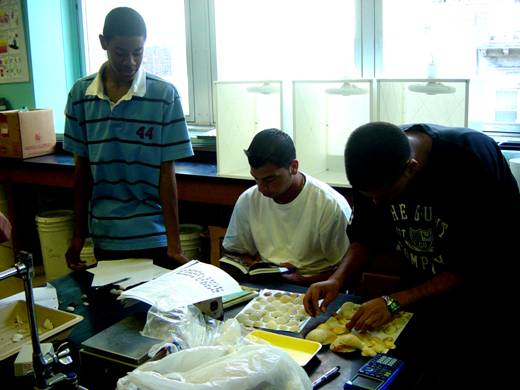Winter 2007 |
|
| PREVIOUS | PAGE 1 | |
From Carnivores to Ovo-vegetarians: Lab Skills for Everyone |
 |
What’s great about the ABLE exercises is that, even if one can’t do the complete lab, there are often ways in which one can incorporate parts of the exercises. We have used parts of several ABLE lab exercises--- the title of my article refers to two of them---one has students determine the fat content of ground meat (Culp 2003) and another measures eggs to learn about statistics (Ratterman et al. 2005) extensively in our Summer Science Academy for high school students. We have utilized college undergraduates as tutors for this three-week long full-day program. By applying skills they’ve learned in their classes, the undergrads become a valuable instrument in mentoring the high school students as well as reinforcing their own skills. The St. Francis College Summer Science Academy has taken place over the past six years through funding from the NY State Legislature and Department of Education. An average of 25 high school students per year have attended over the past six years. The students hail from all over New York City (NYC), and most have not had many quality laboratory experiences. NYC also has a high number of disadvantaged students in the high schools, so we are thus performing a community service, in addition to using the program as a recruiting tool. Coupled with morning lab exercises and skills sessions are afternoon field trips. We travel to museums, go seining in salt marshes, sail on schooners on the Hudson River, and assist with forest ecology projects at Black Rock Forest. We are able to pay the college helpers a small stipend, but because of the uncompensated time they put in, the program becomes transformed into a volunteer learning experience for them. The high school students are much more open with the college students than they are with us “old” professors. On the first day of the program, the high school students conduct the Fat Content in Ground Meat lab (Culp 2003). In this experiment, students weigh a portion of ground meat (the experiment calls for lean hamburger, regular hamburger, and ground turkey, but we have used in addition, beef labeled as 80% lean and 90% lean, and ground turkey, pork, or veal). In the cases where the fat content is labeled, they are testing the hypothesis that the content fat is indeed what is on the label. They mix 25 g of meat with 100 ml of water which they first measure in a graduated cylinder. Then they pour the water over the meat in a beaker and boil for a few minutes to release the fat. The mix is then strained and the liquid is poured back into the cylinder. The students then measure the fat that rises to the top, and calculate this as a percentage of the original mass of meat. The students learn how to keep a lab notebook and how to take simple measurements such as mass, temperature, and volume with a graduated cylinder. I find that the high school students may be familiar with these activities, but that they are not very facile with them. It is a good review for the college students as well. We find that we get better results if we use nylon stockings to filter the boiled meat rather than the stated cheesecloth, and that if we place the cylinders in the refrigerator, it speeds up results. One thing to remember is that we are making the assumption that a milliliter of fat equals one gram. Then the number of milliliters of fat needs to be converted back to a percentage of the ground meat, not of the total volume of water in the cylinder (a common error). We often do not get to the Chi-square portion of the experiment because of time constraints. This is, however, a goal that we are working toward. The college students do learn the Chi-square in a general biology genetics lab, and this would be a good way to reinforce it, although it would be more practical for advanced high school students.
Another popular ABLE experiment that we use a small part of has a somewhat daunting title: “Integration of Biology and Statistics Education (BASE): Measurements of cells and organelles in biology lab to produce large data sets that can be analyzed in statistics classes” (Ratterman et al. 2005). In this experiment we only do the measurement of eggs part. The students measure the length of medium, large, and jumbo eggs with calipers, and, much to their surprise, find that there is much overlap in lengths among these size classes. They graph this so that they are able to see this visually. When asked, “What do you think the sizing categories are based on if not by length?”, invariably, someone comes up with “by weight”. They then proceed to weigh the eggs and graph the weights and note that there is no overlap of the weight of the eggs. We then turn this into an inquiry based experiment, and have tested the following null hypotheses. “There will be no difference in length and weight of eggs of various size classes between regular and eggs labeled as “organic””. “…no difference… between brown and white eggs”, “...no difference…weight of yolks between brown and white eggs”. We found no difference between weight of brown and white eggs; however, the weight of the yolks of brown eggs was less than that of white eggs (in our small sample size). I suggested that perhaps these eggs were lower in cholesterol (another test we could perform in the future)! A third ABLE exercise the students love is the guided inquiry exercise in which students test which is the most absorbent paper towel (Laine and Heath, 2000). The college students purchase various brands of paper towels (and, of course, we also use the school paper towels!), and provide the high school students with a variety of tools to use, including graduated cylinders, rulers, scissors, pipettes, pencils and beakers, Each team of students comes up with a different approach to solving the problem. They write group lab reports about this exercise. Another exercise I use is one that I designed in which the students determine species diversity of a simulated ocean floor population by using sea shells. (Nolan and Callahan, 2005). The collections are from a Brooklyn salt marsh, and Atlantic beaches from Florida to Cape Cod. Often, the salt marsh collection is one that the students themselves gathered on our field trip. The students use field guides to identity the shells, and we put all data on the board for analysis. We use the Shannon-Weiner diversity index which takes into consideration not only the number of species but the proportion that each species comprises of the whole. Each team likes to have “a race” to see whose collection has the highest species diversity!
Before the summer, I will have the college students look through the ABLE proceedings volumes for additional ideas that I can use with the high school students. The more responsibility I give them, the more they seem to enjoy the program. Culp, M. 2003. Fat content in ground meat: a statistical analysis. Pages, in Tested studies for laboratory teaching, Volume 25 (M. A. O’Donnell, Editor). Proceedings of the 23rd Workshop/Conference of the Association for Biology Laboratory Education (ABLE), pages. Laine, P. S. and L. J. Heath. 2000. Introducing inquiry. Pages 417-423, in Tested studies Nolan, K. and J. Callahan. 2005. Beachcomber ecology: the Shannon Weiner species diversity index. Pages, in Tested studies for laboratory teaching, Volume 27 (M. O’Donnell, Editor). Proceedings of the 27th Workshop/Conference of the Association for Biology Laboratory Education (ABLE), pages. Ratterman, D. M., Watrous, J., and D. Lurie. 2005. Integration of Biology and Statistics Education (BASE): Measurements of cells and organelles in biology lab to produce large data sets that can be analyzed in statistics classes. Pages, in Tested studies for laboratory teaching, Volume 27 (M. O’Donnell, Editor). Proceedings of the 27th Workshop/Conference of the Association for Biology Laboratory Education (ABLE), pages.
|
|
| PREVIOUS | PAGE 1 | |

